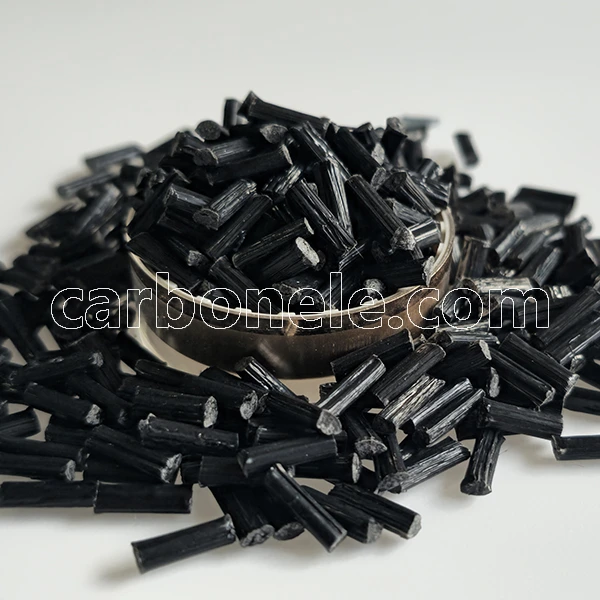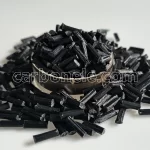
High Quality 30% Long Carbon Fiber PP LCF30 Compounds
PP LCF30 is an exceptional thermoplastic composite. Strengthened by 30% long carbon fibers. Lightweight and strong. In automotive, reduces weight for better fuel economy. Durable, can handle stress and impact.
- Manufacturer: Carbon New Material
- OEM/ODM: Acceptable
- Color: Black
- Free samples: ≤10kg
- MOQ: 100kg
- Port: Xiamen
- Model Number: PP-LCF-BCA3
- Filler Type: Long carbon fibers
What do you know about PP LCF30?
PP LCF30 is an extraordinarily remarkable high-performance thermoplastic composite material. It is expertly strengthened by long carbon fibers with a filling mass proportion of a substantial 30%.
This material presents several truly excellent characteristics. It is strikingly lightweight in comparison to a wide range of traditional materials. For example, it can be several times lighter than certain commonly used metals and plastics. This remarkable lightness is an extremely considerable advantage in various industries.
For instance, in the highly competitive automotive domain, it can play a crucial role in helping to significantly decrease the overall weight of vehicles. A reduction in weight can lead to a substantial improvement in fuel economy, potentially saving drivers a significant amount on fuel costs over time.
Additionally, it helps lower emissions, which is of great importance in today’s environmentally conscious world. At the same time, it boasts outstanding strength and sturdiness. It can endure extremely high stress and impact without showing any signs of deforming or breaking easily. Whether it’s a minor fender bender or a more significant collision, PP LCF30% can provide an added layer of protection and durability.
One Application Case: 30% LCF PP for Engine Hoods
PP LCF30 is a high-performance thermoplastic composite material reinforced by long carbon fibers. The filling mass percentage of carbon fibers is 30%. This material has powerful performance and is widely used. The PP 30%LCF produced by Carbon (Xiamen) New Material has excellent performance in the field of the automotive industry.
Taking the engine hood of a car as an example, the ordinary materials used before were heavy and not strong, resulting in relatively high fuel consumption of the whole vehicle. While the engine hood made of PP LCF30 can reduce the weight by about 20% compared with the previous materials. The reduction of the weight of the whole vehicle means that the vehicle runs more briskly and the fuel consumption is significantly reduced.
In addition, the strength of PP LCF 30 is extremely high. Once, a car equipped with a PP LCF30 engine hood was hit by a small stone rolling down from a truck while driving at high speed. After getting off the car and checking, it was found that the engine hood was undamaged. If the previous materials were used, there would definitely be a large dent, and it might even affect the performance of the engine. PP 30LCF is like a strong guard, guarding the core components of the car.
Carbon (Xiamen) New Material has brought great surprises to the automotive industry. In the future, more cars will definitely use this high-quality material, making travel safer, more efficient and more environmentally friendly.
If you had any interest in the raw materials or other PP LCF composites, please let me know with delay.
Welcome to visit our YouTube account to watch more videos on CFRTPs or click here to read more articles about carbon fiber reinforced thermoplastic compounds. Thank you.
Polypropylene
The quality of polypropylene (PP) can be evaluated from the following aspects: By means of visual examination, physical property testing, combustion test, and checking product labels and certifications, the quality of PP can be comprehensively determined. In practical applications, PP materials of suitable quality can be chosen according to specific requirements and usage situations.

Long Carbon Fibers
High strength, outperforming traditional metals in aerospace and sports. High modulus for shape stability in satellite antennas and precision instruments. Low density for lightweighting in automotive and aerospace. Good corrosion resistance in marine and chemical industries. Good thermal stability in high-temperature applications. Can be conductive for shielding and antistatic. Excellent processing for various products and composites.

Frequently Asked Questions
Carbon (Xiamen) New Material Co., Ltd. aims to provide buyers with "one-stop" worry-free high-quality services. Here you can find all information about carbon fiber engineering plastics. If you still have questions, please send us an email for consultation!
-
How can I contact the manufacturer of a product that interests me?
When you find a product you are interested in, you can contact the manufacturer directly by sending an email and we will get back to you as soon as possible.
-
How do I find the products that interest me?
All you need to do is enter the keyword, product name in the search window and press the Enter key on your keyboard. Your search results page will then be displayed. You can also search within the product category pages on the home page. Each category is divided into subcategories, allowing you to refine your search and find products that interest you.
-
Where will I find a buying guide?
Please contact our after-sales service directly and we will provide you with a comprehensive operating guide.
-
What are CF Reinforced Thermoplastic Composites?
CF Reinforced Thermoplastic Composites are materials where carbon fibers are incorporated into a thermoplastic matrix. They combine the strength and stiffness of carbon fibers with the processability and recyclability of thermoplastics. For instance, they are used in automotive parts like bumper beams.
-
What are the benefits of CF Reinforced Thermoplastic Composites over traditional composites?
The key benefits include faster production cycles, easier recyclability, and better impact resistance. They also offer design flexibility. An example is in the manufacturing of consumer electronics casings where complex shapes can be achieved more easily.
-
How are CF Reinforced Thermoplastic Composites processed?
Common processing methods include injection molding, extrusion, and compression molding. Injection molding is widely used for mass production. For example, in the production of small components for the medical industry.
-
What industries use CF Reinforced Thermoplastic Composites?
They are utilized in aerospace, automotive, medical, and sports equipment industries. In aerospace, they can be found in interior components. In the medical field, they might be used in prosthetics.
-
How does the carbon fiber content affect the properties of the composites?
Higher carbon fiber content generally leads to increased strength and stiffness but may reduce ductility. A moderate content is often balanced for specific applications. For example, a higher content might be preferred in structural parts of a race car.
-
What are the challenges in using CF Reinforced Thermoplastic Composites?
Challenges include higher material costs, complex processing equipment requirements, and ensuring uniform fiber dispersion. Issues with adhesion between the fibers and the matrix can also arise. An example is in achieving consistent quality in large-scale production.























